Content
- 1 Calendula as a siderat in the garden and vegetable garden
- 2 Cadendula - green manure in the garden
- 3 What is calendula like a plant?
- 4 A bit of history
- 5 Planting calendula seeds in the ground - when and how?
- 6 How to choose a place to plant calendula?
- 7 How to care for calendula?
- 8 How does calendula reproduce?
- 9 Collecting calendula seeds - when and how?
- 10 Pests of calendula. How to fight?
- 11 Useful properties of calendula
Calendula as a siderat in private gardening is undeservedly rarely used, summer residents prefer plants that quickly increase a large amount of green mass (for example, mustard, phacelia, rapeseed, oats, lupine, oil radish). However, it is this unpretentious flower culture, which belongs to medicinal plants, that helps in the productive healing of the soil on the site and cleansing it of pests that are destructive for many vegetables.
Calendula as a siderat in the garden and vegetable garden
Despite the fact that in a month and a half the marigolds grow by only 15-25 cm, the overgrown green mass and root residues are quite enough to destroy pathogens, in particular fungi, viruses and bacteria that cause late blight of nightshade, fusarium wilts, various types of mosaics, and clearing the site from nematodes, leaf-eating caterpillars, ticks and wireworms.
During the growing season, the roots of calendula saturate the soil mixture with ethers, phytoncides, tanning components and other biologically active compounds with insecticidal and fungicidal properties. The greens of the plant spread out in the beds, decomposing, enhances the sanitizing effect of these substances. That is why marigolds are among the most effective green manures, which have properties to improve the biochemical composition of the soil in the beds.
Dates of planting calendula as a siderat
The best time for sowing marigolds is the end of August. The plant is planted with the beds freed from the main crops with the expectation that before the onset of soil frosts, the greens will be embedded in the ground.
Cut the greens before flowering, about 1.5-2 months after the emergence of mass shoots. Plant residues are placed in compost, used as mulch or plowed into a fertile soil layer (depth 20-25 cm). Only when plowing, plant residues are not placed tightly, otherwise the structure of the soil is disturbed - the tubules are cut off, where condensate accumulates.
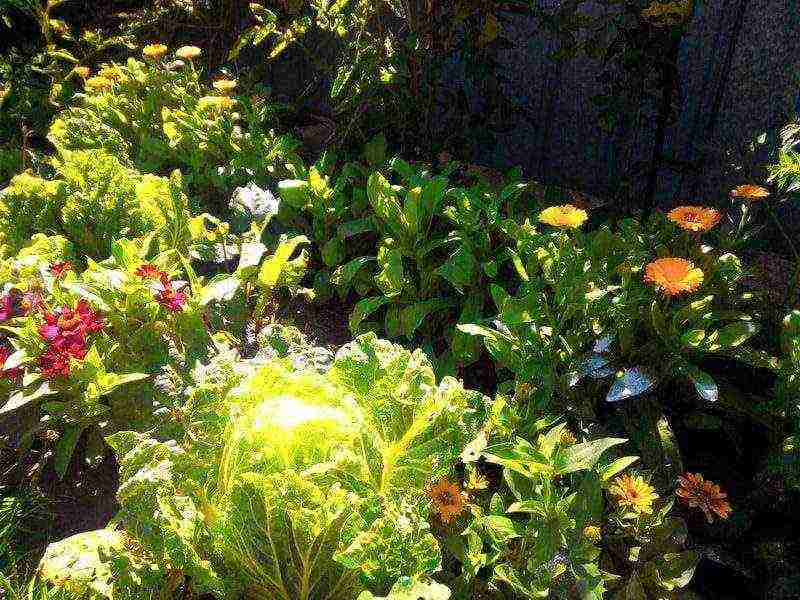
Features of cultivation of calendula
As a green manure culture, calendula is sown densely, the seed consumption rate is from 100 to 150 g / weaving. The organic matter left in the soil during the winter manages to decompose qualitatively and enrich the soil with humic compounds, which create favorable conditions for the activation of beneficial microorganisms and earthworms.
Planting calendula does not require special care. It is enough to water the beds only a few times in dry times. If it rains, then there is no need to organize watering, and the plants independently gain vegetative mass, and in record time.
In the spring, the areas where the marigolds grew are completely ready to receive vegetable crops, which are planted according to the recommended terms.
Calendula is one of the best green manures used before planting tomatoes, potatoes, eggplants, peppers, cucumbers, pumpkin, garlic, onions, carrots and beets.
At our site, we include marigolds in the mixed planting scheme, they beautifully ennoble the garden and are sown wonderfully by self-sowing.In the spring, grown seedlings can be easily transferred to a new place or simply cut off excess seedlings. And in the fall, we do not cut off the grown bushes of marigolds, piling leaf litter right on top like this photo:
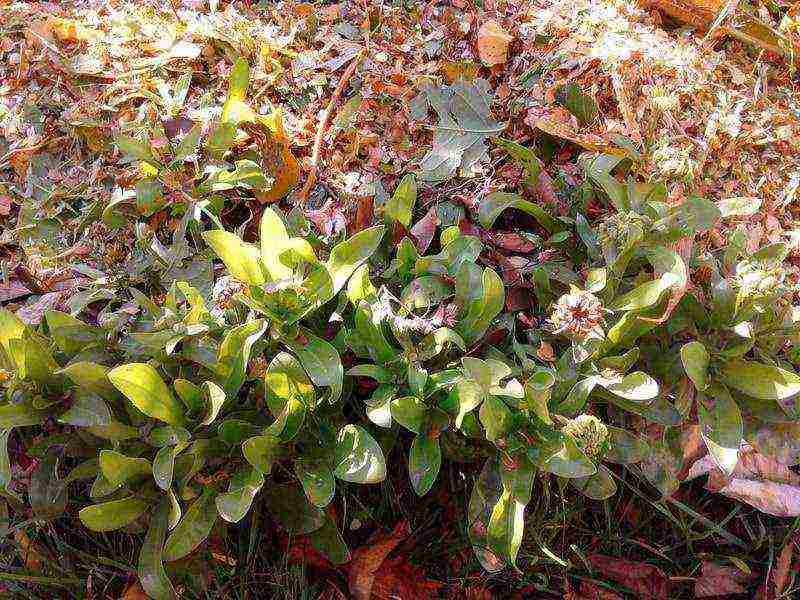
If your site urgently needs improvement, then use the method of sideration with the sowing of calendula officinalis. It is quite easy to collect the seeds from it yourself. So calendula as a siderat in the garden and vegetable garden is a fairly cheap way to disinfect the soil, try it and see for yourself!
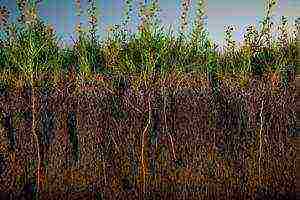
To improve the composition and restore the structure of the soil, and for the enrichment of nutrients, some plants are widely used in organic farming, which are called green fertilizers or siderates.
Some believe that they take their name from the Latin word sidus, meaning star. Although the French scientist of the XIX century J. Ville, who proposed to call these plants "siderates", apparently proceeded from the French word sidérant or striking. Whatever word underlies the name "siderata", they both fit and correctly characterize this type of plant.
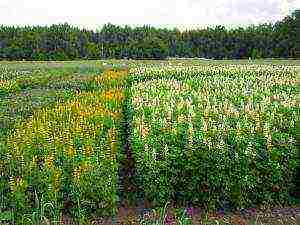
Siderata
From time immemorial, green manure plants have been used by nature and man as a natural fertilizer. Now undeservedly forgotten.
Of course, such a “green manure” requires a much greater investment of time and additional attention. At first glance, it is easier and faster to use the products of the chemical industry for plant nutrition, because mineral fertilizers will perfectly cope with this task. However, nature for millions of years managed on its own and did not resort to the help of artificial synthesis. And the taste of a vegetable, fruit or berry grown without chemicals, is it really an insufficient reward for work and patience?
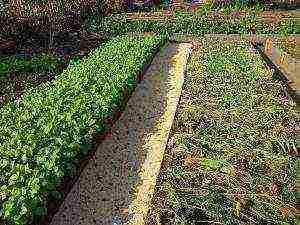
Siderata in the garden
Siderata are plants that quickly gain green mass, which are mowed and embedded in the soil, or left on the surface as a soil protective layer, and the roots of plants remaining in the ground rot, enriching it and forming air ducts. At the same time, they will only decorate your site, since most of them are a beautiful type of plant.
♦ Enrich the soil with nitrogen - after the death of the root system and the aboveground part of the plant, organic matter containing nitrogen passes into the soil.
♦ Loosens the soil and improves its structure - overgrown roots leave numerous tubules, thereby improving the water and air regime of the soil.
♦ Protect the soil from erosion - siderates, as it were, sew the soil from the inside with roots and at the same time cover it with a dense leaf cover on the surface.
♦ Enrich the soil with nutrients - nutrition is extracted from the lower layers, inaccessible to many cultivated plants, thanks to the deeply penetrating powerful root system.
♦ Suppress the growth of weeds - due to thickened plantings, as well as specific secretions of the roots.
♦ With solid sowing, green manure plants in hot summer time do not allow the soil to overheat, keeping it moist and cool.
♦ Suppress the reproduction of pests and diseases - again thanks to the specific secretions of the roots.
♦ Shade the soil - after cutting or dying off, the green mass serves as a natural mulch.
♦ Enrich the soil with organic matter - under the influence of microorganisms and worms, plant residues are converted into humus.
♦ Reproduction of earthworms and soil-forming microorganisms - this is facilitated by a sufficient amount of nutrition and the absence of disturbance from constant mechanical and chemical soil treatment.
♦ Getting rid of soil fatigue - microorganisms, multiplying well in a favorable environment, have time to process all root secretions, including inhibitors.

Siderata in the garden
Also, green manure is used in gardens to improve the composition of the soil and its structuring.The main purpose of growing green manure in the garden is to protect the soil from weeds, weathering and crusting on the surface of the earth after rain and watering. But it is worth remembering that in this case it is necessary to have sufficient moisture in the soil, otherwise garden plants will suffer.
If the soil is severely depleted and low fertile, then the siderates should be grown for a full gardening season - from early spring to late autumn and winter, and next spring, cutting off some and embedding them in the ground, the next ones are immediately sown in order to fill the soil with nutrients as much as possible. In this case, the site is completely occupied by green manure plants.

Siderata
Sowing winter green manures, after clearing the beds from garden plants, protects the soil from wind and water erosion, and the green manures left for the winter retain snow, which contributes to less freezing of the soil and saturation of it with moisture.
If soil fertility is at medium and high levels, then green fertilizers can be sown before or after the main crop, or in mixed plantings - the main crop and green manures are simultaneously grown on the same plot (combining in one bed, a bed through a bed).
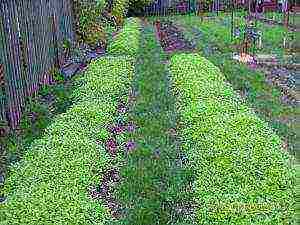
Siderata
As siderates in garden plots, mainly annuals are used, less - perennials, most often from the legume family and plants that give a powerful green mass and have phytosanitary properties.
To choose a green fertilizer that precedes the main crop, it is necessary to take into account that plants of the same family often consume the same nutrients from the soil, have common diseases and pests, therefore it is desirable that the green manure and the main crop are not from the same family.
Who can be a green manure from plants?
Legumesis probably the most numerous and famous species. These are herbaceous plants capable of "extracting" nitrogen from the air. These include: peas, chickpeas, beans, beans, soybeans, lentils. And herbs: vetch, annual lupine, sainfoin, mouse peas, grass plots, alfalfa and clover. When planting clover and alfalfa, one must take into account their ability to grow quickly and braid everything with roots. Simple trimming or mowing is not a hindrance for them.
The next, but no less famous and significant, are cereals: wheat, rye, barley, oats and corn. They sprout quickly and are not afraid of frost. In addition, these are winter crops, which, after sowing in autumn, can be used in spring. When planting winter crops, their seeds must be applied to a depth of 5 cm and sprinkled with earth.
Further Cruciferous- early green manure, which is represented by annual and perennial grasses and shrubs: rapeseed, rape, oil radish and mustard. Cabbage is also cruciferous, but this is rather the main crop.
Green manure plants
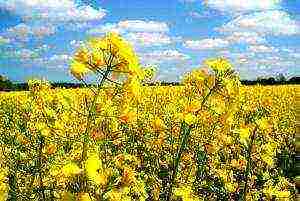
Rape
Rape - a culture widely used in agriculture. It is curious that the plant is nowhere found in the wild, although it has been known to people for a very long time.
In the scientific world, there is an assumption that rapeseed arose from the crossing of winter rape and garden cabbage. Where this happened is unknown, debate among botanists about the alleged origin of the rapeseed continues.
Rape has a developed root system and has the ability to improve the quality and structure of the soil, increase its fertility. The ability of rapeseed to rapidly grow a huge amount of green mass in cold spring and autumn periods is highly appreciated. The biomass of rapeseed, easily decomposing, becomes a valuable easily digestible fertilizer that enriches the soil with phosphorus, sulfur, organic matter, and humus.
It is second only to leguminous green manures in terms of nitrogen content. Rape, like green manure, can compete even with manure in its nutritional capacity. Due to the high content of essential oils, it heals the soil and protects various crops from pests and pathogens.In addition, rapeseed - like green manure - successfully suppresses the growth of weeds, therefore it is often planted in the aisles of perennial fruit and berry crops, in particular strawberries. Solid crops promote the binding of nitrates and reduce their leaching into groundwater.
There are spring and winter forms of the plant, which can sometimes change from one to another. Winter rape is more productive than spring rape, therefore it is more profitable to cultivate it.

Phacelia
Phacelia. An annual plant from the aquiformes family. It is also valuable as a honey plant. Like all green manures, it grows quickly, and on any type of soil, and accumulates green mass.
The biggest advantage of this green manure is that it can be followed by any crop. Phacelia belongs to the gimlet family, to which none of the cultivated plants of the middle lane belongs. It can be sown before and after any vegetables, grains and herbs. Application rates - 8-10 g / sq. Due to its "class affiliation", this plant is suitable for fertilizing lands for cabbage, radishes, turnips, as they are more often than others affected by pests.
Phacelia emerges and develops very quickly (45-55 days), forming lush bunches of greenery growing from one root. It got its name from the shape of the aboveground part, since in Latin, Phacelia is a bundle. Outwardly, she looks very attractive. Purple flowers and carved leaves look decorative and will be appropriate for filling empty spaces in flower beds, flower beds and high ridges.
Phacelia embedded in the soil increases its fertility no less than cow dung. The introduction of tops into the soil (about 100 kg / one hundred square meters) is equivalent to using 1 ton of humus on the same plot of land. But it is possible to prepare plant biomass much faster, and it will cost less than organic fertilizers of animal origin.
Another very useful property of this flower, which is not found in other plants belonging to the conventional class of "green fertilizers" - its nectar attracts entomophages that destroy pests. Moths, aphids and leafworms disappear from the garden plot. Phacelia is often planted as a protective barrier for potatoes in order to protect the planting from pests. The wireworm does not tolerate the neighborhood with it, and the locusts and soil nematodes simply die when the fungicides secreted by its flowers are inhaled. At the same time, this flower does not have a negative effect on bees, and is an excellent honey plant. Some beekeepers specifically plant phacelia in whole plantations in order to obtain flower honey with excellent taste.

Calendula
Calendula belongs to the Aster family. Herbaceous one - or perennial plant, less often a shrub or small tree. Calendula as a siderat is also not often found, but this medicinal plant has all the properties that we expect from a good siderat and even more. Calendula grows rapidly and gains green mass, seeds can be collected in plenty for free on any city flower bed, has a phenomenal healing effect on the soil. Calendula repels the Colorado potato beetle, therefore it is often grown in joint plantings with potatoes and eggplants.
Sowing calendula between the beds of garden and garden crops allows rational use of the land, and also helps in the fight against butterflies and ticks. Neighborhood with calendula can save asters from black legs, and gladioli from thrips. It is the best green manure for tomatoes.
Seed consumption rate per one hundred square meters: 100-150 grams. Calendula is recommended to be planted in early August, cut off after a month and a half before flowering and left before winter.

Mustard white
White mustard. This cold-resistant green manure can be grown and buried several times per season. The last time it is planted before winter, a few weeks before the onset of cold weather.This is done so that the green mass is "beaten" by the cold, and it would remain to rot under a layer of snow. The decay processes will continue for some time, after the onset of negative temperatures, due to the internal heat released during the decomposition of plant organic matter. It is enough to turn green manure fertilizers into humus, which will be very useful for plants in spring.
Mustard grows amicably, and very quickly gains vegetative mass. It is very important not to "miss" the moment when the stems begin to harden. Greens must be mowed until they turn yellow, before the first flowers appear, as soon as the first ovaries of buds have filled.
The minimum period from sowing to planting this plant in the soil is five weeks, but if possible, it is better to wait all eight. When calculating the timing of harvesting, it should be borne in mind that in hot weather, the stems harden faster, in cold weather - slower, so in autumn and spring you can leave greens in the beds for a long time.
Mustard is usually sown "randomly", with the exception of those cases when it is used to protect plants from pests. Then the in-line method is applied. The seed consumption rate of this fertilizer is 4-7 g per 1 sq. If you sow more, then the plantings will thicken, and rotting of greenery on the vine may begin.
To accelerate the maturation of vegetable humus, the green mass obtained from mustard plantings can be watered with a biostimulant. For this purpose, Baikal is perfect, which is diluted in a ratio of 1: 1000 (a drop per liter of water), and the mowed grass is sprayed with the solution with a spray bottle. Under the influence of live bacteria contained in the preparation, the grass rot faster and becomes part of the soil system.
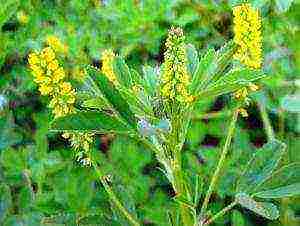
Donnik
Donnik. Previously, this herb was used as a fodder crop for livestock. But then they noticed that when plowing the fields where the sweet clover grew, the land gave richer yields than in the fields that were sown with other grasses. After that, the sweet clover began to be used as a green manure. It is a biennial plant that is grown as an annual. Melilot is unpretentious, hardy and grows quickly. It belongs to the legume family, so it can accumulate nitrogen in the root system. Its roots penetrate deep into the ground, and have a large number of branches. Thanks to the powerful root system of this plant, there is no need to dig up the ground after cutting it. It will be loose without additional processing.
A feature of the cultivation of sweet clover is that the most useful is not the aboveground, but the underground part. Therefore, you can cut the plant in 3-4 weeks after germination. If you let it outgrow, it will become too hard for further processing, and the "pipes" from its stems will stick out of the garden for a couple of seasons, not decorating the garden at all.
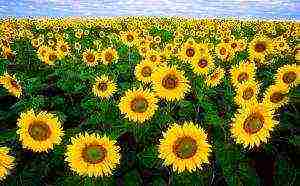
Sunflower
There is another striking representative of the Astrovian - Sunflower. It can also be used as a green manure, just keep in mind that its stem, like corn, quickly becomes tough and therefore slowly decomposes. It is best used as protection from direct sunlight or as a support for other plants.
Vika (mouse peas) - the plant is early ripening, and has a short growing season, which allows it to be used as a catch crop between plantings of main crops. For example, it can be planted in beds intended for seedlings of tomatoes, peppers and eggplants. It can also be sown in front of melons and gourds. Pumpkin, zucchini, squash planted on vetch give excellent harvests.
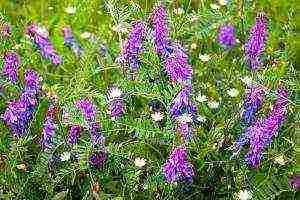
Vika (mouse peas)
Planting of green manure is carried out throughout the growing season, as soon as temperatures above zero are established. Sowing rate - 1.5 kg per one hundred square meters. The seeding depth is 1-3 cm. It is not necessary deeper, otherwise the plant will not be able to penetrate the surface layer of the soil.To accelerate the emergence of seedlings, the plot can be watered with EM fertilizers, it is cheap and fast.
Vetch is often included in a mixture containing green manure plants such as rye, oats, rapeseed and ryegrass. This is done to obtain the optimal composition of vermicompost, which is formed after mowing these crops, since this plant accumulates mainly nitrogen. "Mouse peas" belong to the legume family, and, accordingly, has a similar structure. On its roots, the same nitrogenous nodules are formed, which accumulate this element. Peas, beans and beans should not be planted after it. But potatoes, cabbage, radishes, cucumbers and greens will be excellent follow-up crops.

Oil radish
Oil radish - a unique green manure, with a rapidly growing aerial part. In 6-7 weeks, it can increase its vegetative mass by 4-5 times. It is popular among gardeners as a natural "agrokiller". Radish suppresses all weeds, even creeping wheatgrass.
This green manure is not only an active supplier of biomass. Radish is a natural doctor and earth cleaner. It successfully fights diseases such as cabbage keel and nematode. It must be planted on lands that have been affected by various diseases and insect pests for several seasons, and the soil will become healthy again.
It is best to sow radish on fresh plowing; it loves soft soil. Seed consumption - 300 g per hundred square meters. 4 weeks after the emergence of full shoots, the aerial part of the plant is excised with a shovel, and dug up together with the soil. The thickest stems are best composted.

Lupine
Lupine. Common lupine is considered one of the oldest green manures in the history of agriculture. To enrich the soil, poor in nitrogen, it was used in Greece, more than two thousand years ago. Gardeners completely buried the trunk and leaves without roots in the near-trunk circle of the fruit tree, and there was enough nitrogen for that for several months.
This plant belongs to the legume family, respectively, beans, peas and beans cannot be planted after it, these crops have common pests. Tomatoes, cabbage, peppers will be excellent followers for lupine. And for potatoes, this beautiful flower will be the best predecessor.
The powerful roots of the plant are an active leavening agent, penetrating deeply into the soil. In parallel, they have another positive effect - they saturate all soil horizons with nitrogenous bacteria. Lupine plantings are capable of accumulating about 200 kg of nitrogen per hectare in the ground.
This green manure is planted in early spring, in a row method. Seed consumption (and they are quite large) - 4-5 per sq. When the lupine reaches the age of 5-7 weeks, its tops are plowed into the ground. Even if it bloomed, this is not scary, the most important thing is to prevent the formation of seeds, since at this stage of plant development, the stem becomes tough and does not rot well in the soil.
The great advantage of the plant can be considered a tap root system, which goes deep into the ground, and receives most of the nutrients from the deep layers, without depleting the upper fertile layer. At the same time, vermicompost, obtained from the aerial parts of lupine, per 1 sq. M. replaces 4 kg of manure, or 40-50 g of urea.
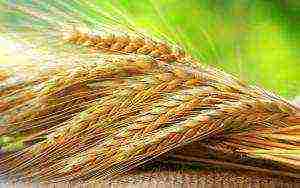
Rye
Rye. In many regions of the country, it is customary to sow the garden with this cereal after digging up potatoes. The rye bushes well, and builds up a large green mass, reaching 200-300 kg per hundred square meters. This green manure is planted both in winter and in spring, the planting time does not affect its quality. The special value of winter rye is that it actively increases its biological mass even at rather low temperatures, and winter crops survive even in snowless winters, with frosts down to -25 ° C.
The downside of all cereals grown to enrich the soil, including rye, is the complexity of their subsequent processing and plowing.The stems have a fairly strong structure, decompose for a long time, and cling to the plowshares, which have to be cleaned all the time. Another disadvantage of this winter green manure can be considered that it dries up the soil greatly, so it is impossible to sow rye in the garden between the trees.
Otherwise, this cereal is an excellent fertilizer, the seeds of which are inexpensive and therefore available to everyone. Rye is undemanding to the quality and thickness of the soil layer, perfectly sods loose soils, easily tolerates high acidity. Since this plant has a fibrous root system, it easily retains nutrients in the upper soil horizon, preventing them from being washed out with melt water and rainwater.
The big advantage of this green manure fertilizer is that when decomposing, it saturates the soil not only with nitrogen, but also with calcium. Microorganisms contained in cereal biomass create conditions for the absorption of difficult-to-digest phosphorus compounds, dissolving them. Accordingly, a complete NPK-complex of nutrients remains in the ground, which allows any culture-followers to fully develop.
The aboveground part of cereals after cutting is used not only for plowing. The resulting straw is used as mulch. It provides excellent protection of the soil from drying out, and does not allow weed seeds to break through to the surface. Subsequently, decomposing, fresh straw becomes part of the garden bed, turning into vermicompost.
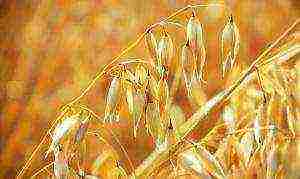
Oats
Oats. This cereal crop is used as green manure less often than rye. But this is more an accident than a pattern. The plant has all the positive qualities of rye, while it also wins over it in some respects. For example, oats are even more unpretentious. It can be sown on acidic podzolic soil, clay, and even peat - it will grow everywhere.
As an element of crop rotation, it is sown after legumes, preparing the land for potatoes. Despite the apparent weakness of the fibrous root system, this plant perfectly loosens the earth to a great depth, enriching it with oxygen, and creating a structure that is comfortable for cultivated plants. Oats saturates the upper soil layer with nitrogen and potassium, and, like rye, decomposes difficult-to-digest phosphorus compounds.
Seeds of this culture are planted, scattering them over the surface of a previously loosened plot of land, in early spring, as soon as it is possible to enter the garden. Do not be afraid of dirt and cold - oats love them, and these parameters do not affect its germination. On the contrary, in late March - early April, optimal conditions are created for the germination of oats, since they can feed on soil moisture from the melted snow. The seeding rate is 1.5-2.1 kg per hundred square meters, the seeding depth of seed is 4-5 cm.
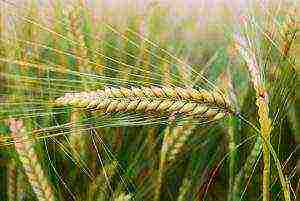
Barley
Barley as siderat is good as well as rye or oats. It also structures the soil well, suppresses most weeds and quickly gains green mass. But barley has its own special advantage: it is drought-resistant, in contrast to the same oats. Therefore, in areas where droughts are frequent, it is better to prefer barley as green manure. Barley is very good for early spring planting, it can withstand frosts down to -5 ° C. Seed consumption rate per one hundred square meters: 1.8-2 kilograms. Mowed in a month and a half after disembarkation.
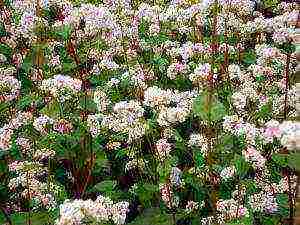
Buckwheat
Buckwheat - one of the record holders in terms of growth rate, it quickly reaches a height of half a meter, and even manages to grow 1.5 meters of roots. This green manure is not afraid of drought and does not dry out the soil.
Very often buckwheat is planted in the near-trunk circles of fruit trees and bushes. Buckwheat leaves behind colins (substances that inhibit the development of subsequent plants) less than other green manure plants. Buckwheat is recommended to be used as a green manure on poor, acidic and heavy soils.
It will grow anywhere, and after mowing will significantly enrich the soil with phosphates and potassium. Suppresses perennial weeds, especially wheatgrass. Seed consumption rate per one hundred square meters: 600 grams. Buckwheat is sown in late spring, in May, as it is thermophilic. Mow the green mass before flowering. You can sow buckwheat before winter.

Amaranth
And finally Amaranth. It is not often used as a green manure in our plots, most often it is grown as a vegetable crop or for obtaining seeds. It is no less important as a green manure than all the previous ones, because it contains essential amino acids, a large amount of protein and minerals. This plant does not have any special requirements for the soil, it grows even on salt marshes. Does not like waterlogging, drought-resistant, practically not susceptible to disease. Amaranth roots go deep into the soil (up to 2 meters), improving its structure. Since amaranth is thermophilic, it is planted either in late spring in a specially designated area, or in the summer after harvesting early crops. The landing rate is 15 grams per hundred square meters. Before sowing, 2 teaspoons of amaranth seeds are mixed with a glass of sand and must be rolled for better contact with the ground. The green mass of amaranth is harvested before frosts, or before flowering.
|
Growing potatoes in oats Agricultural technologies, like any others, do not stand still. In modern horticulture, the technology of growing crops without prior plowing of the land is increasingly being used. It allows you to save not only energy and time, but also to get excellent harvests. Siderata, as part of a crop-free farming culture, are actively used in this system. Oats can be not only a supplier of vermicompost. His can be used for potatoes by growing tubers in oat straw mulch. Moreover, on the plot, which is planned for this culture, you do not even have to remove the grass, it will disappear by itself, passing into the composition of the nutrient soil. It is only necessary to slightly push it apart, and in between to make grooves in which oats are planted.
When the siderata and weeds grow up enough, they are mowed under the root with a flat cutter, and, having made a small depression in the soil, they plant a potato there, lightly sprinkling it with a layer of earth. The sprouts that appear are mulched with straw and grass, and when they become very large, they gradually add other green waste, for example, the grass left after mowing the lawn. Most importantly, it is necessary to block access to the tubers of the sun's rays, which will "green" them, making the potatoes unsuitable for human consumption. After the autumn harvesting of potatoes, which, by the way, will become a very clean and quick process, the field must be sown with oats again, and continue to do this every year. In a couple of years, without digging, the soil structure will be completely restored, and this plot of land will give consistently high yields. |
Siderates can be conditionally divided into groups according to their functions
♦ Accumulation of nitrogen from the atmosphere - legumes;
♦ Converting phosphates into digestible forms - legumes, mustard and buckwheat;
♦ Assimilation of nitrogen from the soil, protection against soil mineralization and leaching of nutrients into the subsoil - cruciferous, cereals;
♦ Deep loosening of the soil - mustard, radish, lupine, sainfoin, buckwheat;
♦ Protection against nematodes - legumes, sunflowers, phacelia, ryegrass.
Approximate sowing dates for some green manure crops
♦ Any terms - sweet clover, mustard, phacelia.
♦ In early spring - spring - lupine, buckwheat, oats, alfalfa.
♦ Early summer - summer - mustard, phacelia, clover, alfalfa, vetch, peas, clover, rapeseed.
♦ In autumn - clover, winter rye, winter oats, oil radish.

Sealing siderates in the garden
When sowing green manures in the garden, an ordinary method is used with a row spacing of 15 cm and a continuous one, taking into account the seeding rates for various plants, conditions and purposes.Plants grow faster and better if, after sowing, the soil is rolled (increasing the area of contact of the seed with the soil) and moistened.
In traditional farming, soil with green manure is dug up, but digging or plowing violates the structure of the soil and destroys beneficial microorganisms. Therefore, in natural farming, siderates are cut with a flat-cutting tool to a depth of 5 cm, leaving roots, which, after decomposition, form tubule systems, and the green mass is left on the garden bed, preferably covering them with a mulching layer so that they do not dry out.

Sealing siderates using a walk-behind tractor
Young plants, upon decomposition, release a large amount of nitrogen, quickly decompose and the main crop is planted 3-4 weeks after planting. Mature plants with a tough stem form carbon compounds, consume nitrogen and take much longer to decompose, so it is advisable to avoid coarsening of the plants and remove them when they gain sufficient green mass.
Mowed and introduced into the soil green manure plants gradually decompose under the influence of soil microorganisms, earthworms and other soil living creatures and turn into organic matter and humus, releasing nutrients that are readily available for subsequent cultivated plants.
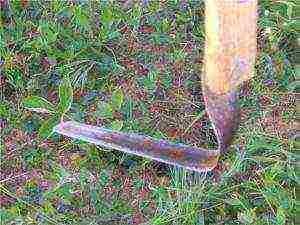
Sealing siderates using a Fokin plane cutter
Red clover, sweet clover, sainfoin and sowing alfalfa are used for greening in gardens. If the garden is young, then it is better to sow it with annuals: beans, peas, rank, seradella, lupine and winter vetch. Perennials, when a large aboveground mass is formed, are mowed, but removed from the garden area, forming a lawn. Perennial green manures are harvested and plowed into the ground in the last year of their life, before or in the middle of flowering, if possible without disturbing the structure of the soil, and after a couple of years the site is not sown to give time for the decomposition of the remaining roots.
It is also worth noting that tree trunks are rarely sown, they should be free of vegetation so that there is no negative impact on tree roots.

Siderata
The use of green fertilizers allows you to restore the soil balance, save money on purchased fertilizing, and grow environmentally friendly products. The use of green manure helps to create a new humus layer, which was destroyed by the use of traditional agriculture, when all the nutrients were taken out of the soil with the resulting products. The soil enriched with natural methods will be transformed, and will certainly thank you for all your efforts with abundant harvests of environmentally friendly vegetables and fruits.
You might be interested in:
 Everyone has probably heard about the medicinal properties of calendula. But I have never heard of the fact that calendula is used as a kind of green manure that counteracts fungi and viruses in the soil. Therefore, I am pleased to quote a note from a friendly site about the experience of eco-farmers from Kazakhstan.
Everyone has probably heard about the medicinal properties of calendula. But I have never heard of the fact that calendula is used as a kind of green manure that counteracts fungi and viruses in the soil. Therefore, I am pleased to quote a note from a friendly site about the experience of eco-farmers from Kazakhstan.
Cadendula - green manure in the garden
Calendula in the garden as a siderat is used unfairly rarely. Summer residents give preference to plants that quickly grow a large amount of green mass (for example, mustard, phacelia, rapeseed, oats, lupine, oil radish). However, it is this unpretentious flower culture related to medicinal plants that helps in the productive healing of the soil on the site and cleansing it of pests that are destructive for many vegetables.
Despite the fact that in a month and a half the marigolds grow by only 15-25 cm, the overgrown green mass and root residues are quite enough to destroy pathogens, in particular fungi, viruses and bacteria that cause late blight of nightshade, fusarium wilts, various types of mosaics, and clearing the site from nematodes, leaf-eating caterpillars, ticks and wireworms.
During the growing season, the roots of calendula saturate the soil mixture with ethers, phytoncides, tanning components and other biologically active compounds with insecticidal and fungicidal properties. The greens of the plant spread out in the beds, decomposing, enhances the sanitizing effect of these substances. That is why marigolds are among the most effective green manures that improve the biochemical composition of the soil in the beds.
When to plant calendula as a siderat
The best time to sow marigolds is the end of August. The plant is planted with the beds freed from the main crops, and the greens are cut off before flowering, about 1.5-2 months after the emergence of mass shoots. Plant residues are placed in compost and used as mulch.

Cultivation of calendula
As a green manure culture, calendula is sown thickly, the seed consumption rate is from 100 to 150 grams per hundred square meters. The organic matter left in the soil during the winter manages to decompose qualitatively and enrich the soil with humic compounds, which create favorable conditions for the activation of beneficial microorganisms and earthworms.
Planting calendula does not require special care. It is enough to water the beds only a few times in dry times. If it rains, then there is no need to organize watering, and the plants independently gain vegetative mass, and in record time.
In the spring, the areas where marigolds grew are completely ready to receive vegetable crops, which are planted according to the recommended terms.
Calendula is one of the best green manures used before planting tomatoes, potatoes, eggplants, peppers, cucumbers, pumpkin, garlic, onions, carrots and beets.
At our site, we include marigolds in the mixed planting scheme, they beautifully ennoble the garden and are sown wonderfully by self-sowing. In the spring, grown seedlings can be easily transferred to a new place or simply cut off excess seedlings.
If your site needs improvement, then use the method of sideration with sowing calendula. By the way, its seeds are quite easy to collect on your own. So calendula as a siderat in the garden and vegetable garden is a very affordable way to disinfect the soil. Try it and see for yourself!
Everyone knows what a calendula looks like. Even those who do not know that it is called that. Even those who are used to calling these flowers marigolds. And it is not surprising - this simple and at the same time such a sunny flower has been accompanying us since childhood! He could be seen in the flower beds around the kindergarten, and he can still be seen on the lawns along the sidewalks on the way to work.

Calendula is also a welcome guest on the personal plot. And if you still do not have an answer to the question of how to plant and care for calendula outdoors, then this article is for you!
What is calendula like a plant?
Calendula (she is also marigold) belongs to the genus of herbaceous plants and belongs to the Astrov family. Inflorescences are in the form of double and semi-double baskets of yellow or orange color.
Annual. The seeds are curved, arranged in several rows, and are heteromorphic. Marigolds come from the Mediterranean and Western Asia, today they are also common in areas with a cool climate. Popular for their medicinal and decorative properties.
A bit of history
The healing and decorative qualities of calendula have been noticed by people for a long time. Mentions of it are found in the works of doctors of the Ancient World and the Middle Ages, great poets of the past sung in their poems, and the crowned heads of France preferred calendula to all other plants for palace flower beds. It was also used in cooking - on the tables of poor people, it successfully replaced the insanely expensive saffron.
Planting calendula seeds in the ground - when and how?
In the case of growing calendula from seeds - when to plant? This question is very important, since the time of their flowering will also depend on the time of planting our marigolds. In terms of time, two types of planting are distinguished:
- Autumn;
- Spring.
Autumn planting occurs in October. Its indisputable advantage is the earlier flowering of marigolds, as well as their increased resistance to the vagaries of the weather and diseases.
Spring planting is in April. Marigold seeds are sown in small piles at a distance of about 20 centimeters from each other with a depth of no more than 3 centimeters. The sprouts begin to appear in 1-3 weeks and, as soon as this happens, the planting must be thinned out. It is very important to do this, otherwise the flowering will not be plentiful. The sprouts pulled out during thinning can be planted somewhere else, since this flower takes root easily. Flowering will begin approximately 1-1.5 months after sowing.
With any method of planting, the soil should be dug up, fertilized with humus and dug again, and then leveled.
Important! Joint planting of terry and non-terry varieties is not recommended, since they quickly become cross-pollinated and, accordingly, lose their decorative qualities.
How to choose a place to plant calendula?
For everyone who is interested in the "heroine" of our article, it is important to know not only when to plant marigolds when growing from seeds, but also where to sow. Marigolds love sunny, moderately humid places, but they grow just as well in partial shade. At the same time, they are badly affected by heat and drought, which means that in the absence of rain, the plant needs to be watered about 3 times a week.
There are two places where marigolds are usually planted:
- Flower beds;
- garden aisle.
In the first case, ridges and borders act as flower beds, and the most spectacular neighborhood for our marigolds is given by purple and blue tones of other flowers - ageratums, alissums, delphiniums. But just the green background of the lawn will be enough to make the bright suns of the marigold inflorescences look great! For these purposes, it is better to use their medium-sized varieties.
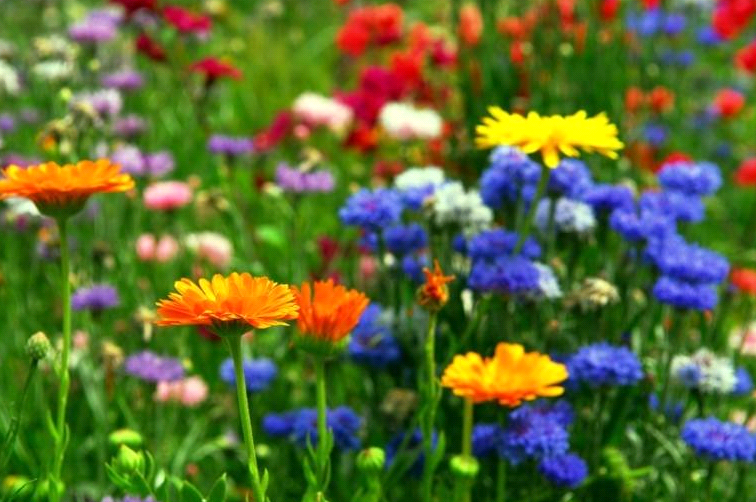
In the second case, the landing is done not for the sake of beauty, but for the sake of benefit. Marigolds are able to rid the garden of pests such as scale insects and ticks. Potato plantings can be grateful to them for getting rid of Colorado beetles. Marigolds, like a green manure plant, have a beneficial effect on the phyto-properties of the soil, therefore they are not cut off in the fall. The only plants not worth planting our marigolds next to are radishes and basil. For planting in the aisle, preference should be given to undersized varieties that do not give a lot of shade.
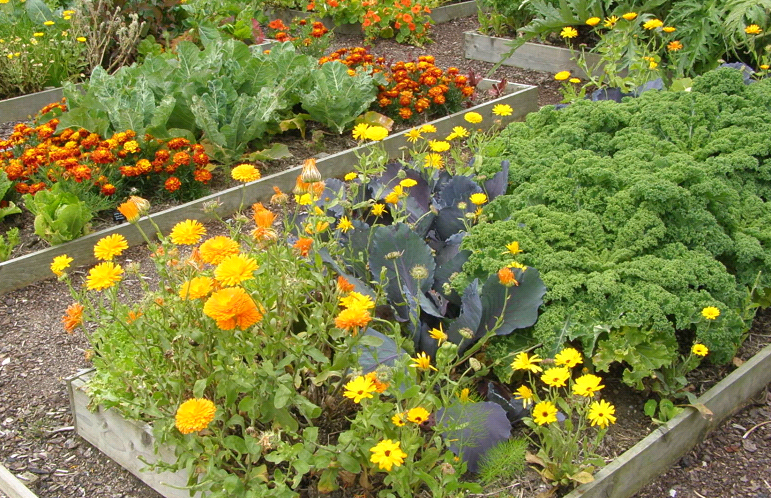
How to care for calendula?
Calendula is loved by many also because it does not require any special care. All she needs:
- Timely watering;
- Soil mulching;
- Top dressing with infusion of weeds.
Just like other ornamental plants, withered leaves and flowers must be removed from marigolds in a timely manner.
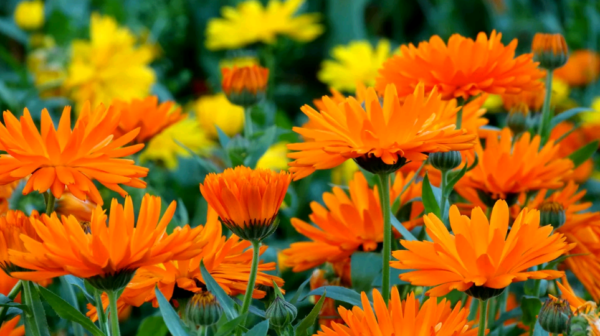
Calendula will bloom for a long time and luxuriantly if you pick off the opened flowers immediately after all the petals of the basket take a horizontal position!
How does calendula reproduce?
Reproduction takes place at the expense of seeds, which are formed in the seed capsule in the center of the inflorescence. By the way, sometimes there is no need to sow marigolds in the same place as last year - due to the fact that the seeds of marigolds are frost-resistant, they are able to perfectly reproduce on their own.
Collecting calendula seeds - when and how?
The cultivation of flowers such as marigolds is not complete without collecting seeds and is carried out in August - September. By this time, the flower itself has already faded and only compactly located brown seedlings remain in its place. They should be carefully separated from the base and folded in a place where they can dry out. Store marigold seeds in paper, ensuring minimum moisture and air access.
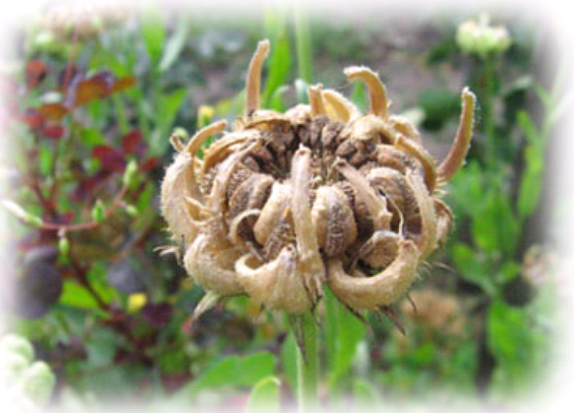
Pests of calendula.How to fight?
The following pests can be dangerous for marigolds:
- Slugs;
- Aphid;
- Scoops;
- Powdery mildew.
To protect plants, they should be treated with a special fungicide preparation, which can be purchased at the store. It is important to have time to do this before the marigolds begin to bloom.
Useful properties of calendula
Calendula has many health benefits.
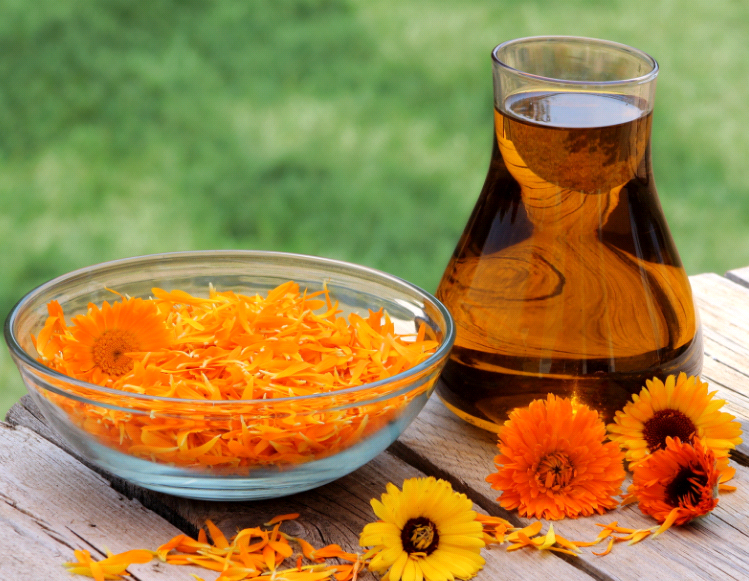
It can be applied in two ways:
- Inside;
- outwardly.
Inside, a tincture of marigolds is used, which can cure stomatitis, sore throat, tonsillitis.
Outwardly, it is used in the form of ointments and oils. The ointment helps with burns, cuts, bruises. The oil can be effective in treating pressure sores and dry eczema.
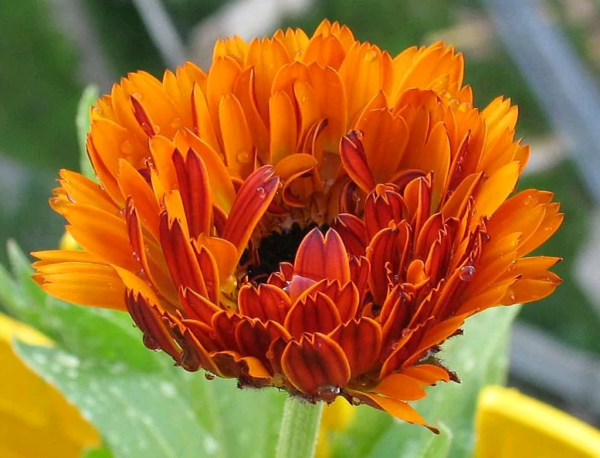
At the end of the article about calendula, we can say that this is perhaps a plant without flaws! The suns of its inflorescences are pleasing to the eye, help to grow crops and get rid of ailments. And all this with a minimum of care and maintenance! We hope that this article will answer all your questions about marigolds, and you will definitely devote a significant place for them on your personal plot!




